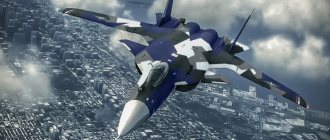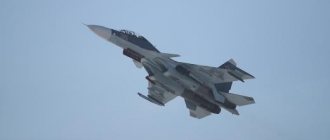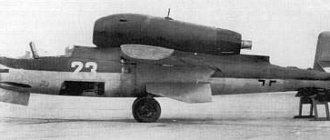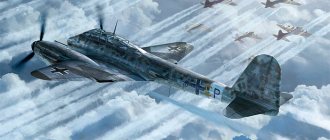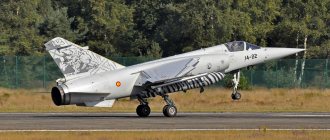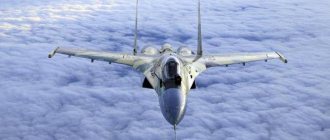| MiG-23 | |
| Type: | Third generation multi-role fighter |
| Developer: | OKB A.I. Mikoyan, MMZ "Banner of Labor", Irkutsk Aviation Plant. |
| Chief designer: | Andreev A. A. |
| First flight: | June 10, 1967 (23-11 prototype) |
| Start of operation: | May 1969 |
| Status: | Operated |
| Main operators: | USSR (former) India (former) Syria Libya |
| Years of production: | 1967 — 1985 |
| Units produced: | 3630 (fighter modifications) 769 MiG-23UB |
| Options: | MiG-27 |
The MiG-23 (product 23-11, according to NATO codification: Flogger ) is a Soviet multi-role fighter with a variable sweep wing. An experimental aircraft with variable sweep wings “23-11” made its first flight on June 10, 1967 under the control of test pilot A. V. Fedotov.
Production
Serial production of the new fighter was carried out in Moscow. The need to further improve avionics and weapons, as well as improve maneuverability characteristics, required a radical improvement of the aircraft. The modernized MiG-23M was equipped with a new engine, equipment, an external ventral fuel tank and a wing with an increased area and improved aerodynamics. Requirements for a further increase in maneuverability, caused by the emergence of fourth-generation fighters in the United States, led to the creation in 1974 of the lightweight MiG-23ML fighter. The aircraft received improved equipment and a more powerful engine. Changes were made to the airframe design - the fork and fuselage were shortened. The aircraft was mass-produced for the Soviet Air Force from 1976 to 1981, and for export until 1985. Based on the MiG-23ML, the MiG-23P air defense interceptor was created with a different set of equipment.
At the end of the 1970s, production of the latest and most advanced modification began, the MiG-23MLD. The improvements concerned primarily the fuselage design and were intended to improve the aircraft's stability characteristics at high angles of attack. The fighter was equipped with an improved radar capable of tracking up to 6 targets simultaneously. To protect against man-portable anti-aircraft missile systems, container blocks with infrared traps were installed on the fixed parts of the wing.
Twelve MiG-23MLD and two combat trainer MiG-23UB in the period from the end of 1984 to the beginning of the 1990s. were based at the Soviet naval and air force base of Cam Ranh, where they carried out base air defense tasks. Since the aircraft did not have enough flight range even with drop tanks for relocation from the Khvalynka airfield (Spassk-Dalniy, Primorsky Territory), the aircraft were dismantled into technological compartments and preserved in special containers in the shortest possible time. In these containers, first by rail to Vladivostok, and then by ship, the planes were delivered to Vietnam. After the containers arrived in Cam Ranh, the fighters were assembled, tested and flown for several weeks, after which the squadron began to carry out its assigned tasks.
At the moment, all MiG-23 of the Russian Air Force are put into reserve and are located at storage bases.
MiG-23 Dimensions. Engine. Weight. Story. Range of flight. Service ceiling
In the early 1960s. OKB A.I. Mikoyan began to show interest in aircraft with variable geometry wings, which had a noticeable advantage. According to the military, in the event of a full-scale war, large airfields with concrete runways will become too vulnerable and therefore aircraft that can be operated from shortened runways are needed. This could be achieved in two ways: through the use of lifting engines or using a wing with variable geometry.
Part of the equipment
- Radar "Sapphire-21" (MiG-23S and MiG-23MS),
- pulse-Doppler radar "Sapphire-23D" (MiG-23M and MiG-23MF, detection range of MiG-21 class air targets - 55 km, acquisition range 35 km), "Sapphire-23ML" (Mi G-23ML, detection range of air targets 85 km, acquisition range 55 km) or Sapphire-23MLA (MiG-23MLD);
- heat direction finder TP-23, TP-23-1, TI-23M (MiG-23ML, detection range of air targets in the rear hemisphere up to 35 km) or TP-26 (60 km);
- air-to-surface missile guidance station "Delta-N" (MiG-23S or "Delta-NG");
- the Lazur-S (MiG-23S), Lazur-SM (MiG-23M) or Lazur-SML (MiG-23ML) system, which provides automatic aircraft guidance using the Vozdukh ground control system;
- ILS ASP-PF (MiG-23S), ASP-23L (MiG-23L) or ASP-17ML (MiG-23ML);
- radio station R-832M or R-862 (MiG-23MLD);
- emergency radio station R-855UM;
- navigation system “Polet-1L-23” (MiG-23S, MiG-23M) or “Polet-2L-23” (MiG-23ML);
- automatic radio compass ARK-10 or ARK-15M;
- marker radio receiver MRP-56P;
- radio altimeter RV-UM (MiG-23S) or RV-4;
- aircraft equipment of the short-range navigation radio system RSBN-6S;
- respondent SO-69;
- SPM warning and warning system;
- active radar jamming system "Reper" N;
- automatic control system SAU-23A (MiG-23S, MiG-23M), SAU-23AM;
- system of limiting signals SOS-3-4 (MiG-23MLD).
MiG-23 late series are equipped with containers with IR traps (located above the fixed part of the wing).
A rash of mines, and more of them!
Moreover, despite the absence of an air enemy, our pilots’ tasks were through the roof. After all, the war had been going on since 1979, and not with the regular army, but with militant detachments. In fact, a complete analogue of the Vietnam War. Therefore, our aviation had to perform the same tasks as the American ones. Mi-8 helicopters and An-22 military transport aircraft delivered cargo. The An-22, of course, went to large airfields like Bagram, and the Mi-8 rushed like bees all over Afghanistan: either throwing a reconnaissance group to some height, or delivering ammunition to a remote garrison. Mi-24 fire support helicopters were engaged in escorting transport convoys and supporting ground troops during the clash. Well, Su-25 attack aircraft or Su-24 front-line bombers wreaked havoc in the enemy’s ranks, smashed strong points to pieces, and if reconnaissance missed or made a mistake, then even villages. What's there to hide? And this happened, alas. But few people know that our aviation was also engaged in... mining! Yes Yes! Exactly! Mines could be placed from the air. Some kind of “dryer” or helicopter will fly over the gorge, and... it seems that nothing happened. It seems that no one was fired at, no one was blown up. And then people’s and donkeys’ legs and arms will start to come off. It turns out that when the plane flew over, it dropped several containers with mines. The container opens up at a height and mines fall to the ground like metal rain, somewhere on the path of caravans with weapons. The most problematic area for mine laying was the border with Pakistan. And it was a matter of geography. In the very science that these parts have never heard of. Therefore, no one knew where exactly the border between Afghanistan and Pakistan lay. Even the locals. The border meandered through gorges, climbed passes, jumped from one peak to another, and sometimes divided villages and auls into two parts - Afghan and Pakistani. If the special forces, who had been fighting in these mountains for several months, knew that behind that mountain was Pakistan, then it was difficult for the pilots from above to distinguish one stone bump from another. And, given the speed, the miss could sometimes be up to 50 km in one direction or another.
Export
MiG-23 aircraft of various modifications were supplied to the Air Force and Air Defense Forces of the USSR, the Air Forces of Algeria, Angola, Bulgaria, Cuba, Czechoslovakia, Germany, Egypt, Libya, Hungary, Iraq, India, North Korea, Ethiopia, South Yemen, Poland, Syria, and Vietnam.
During testing of the MiG-23 received from Egypt, US Air Force Lieutenant General Robert Bond died on April 26, 1984 (a number of sources erroneously claim that he died while testing the new F-117 stealth aircraft).
Tragic mistake
And there were other cases, more tragic. At the end of July 1981, a Mi-8 group took off from Kandahar, whose task was to land a group of sappers in order to mine the road leading from Peshawar to Jalalabad. They entered the operation area secretly, landed sappers, they laid mines and the helicopters headed for the base. They walked five kilometers when suddenly a border point between Pakistan and Afghanistan appeared below them. It turns out that the Pakistani section of the road has been mined! The helicopters urgently turned back to have time to remove the mines. But it was already too late—exploded civilian cars were burning out on the road and roadsides. Here is another incident that happened in December 1981. A pair of Mi-8s flew out from the air to lay mines under the cover of a Mi-24. The task was to place mines on the paths in the Khyber Pass, a well-known route for caravans with weapons. The leader of the group was the navigator of the 40th Army Air Force who had arrived from Kabul and knew the area only from the map. Well, but the bosses. And so we went out into the area, dropped mines, and suddenly it turned out that… a railroad was passing under our helicopters! And this was at a time when in Afghanistan sleepers could only be found as fence supports. It turned out that our pilots had mined the suburbs of the Pakistani city of Landa Khan. It is not difficult to guess that the government of Pakistan, which already did not favor the USSR, after such tricks decided that it was necessary to somehow deal with border violators.
Modifications
- MiG-23S is the first production fighter of the MiG-23 model. The aircraft made its first flight on May 21, 1969. Equipment: R-27F-300 turbofan engine, RP-22 radar, heat direction finder, ARK-10 radio compass and ASP-PF drive system equipment.
Produced in 1969-1970. in Moscow at the MMZ “Znamya Truda” (currently PC No. 2 of JSC RSK MiG). The name in production is “Product 22”.
- MiG-23UB is a Spark combat training aircraft. Produced in 1970-1978. in Irkutsk.
- The MiG-23M is an aircraft with a larger wing area, improved aerodynamics, and a more powerful power plant (TRDF R29F-300). The fighter's equipment included an improved Sapphire-23D radar, a TP-23 heat direction finder and an ASP-23D optical collimator sight, which made it possible to use medium-range missiles R-23R (radar semi-active guidance system) and R-23T (IR homing), and also the K-13M short-range IR homing missile. , name in production of MiG-23M/MS/MF aircraft is “Product 2”.
- The MiG-23MS and MiG-23M with simplified on-board radio electronics and weapons were intended for export in 1973.
- MiG-23MF - had a simplified radar, compared to the MiG-23M, intended for the Warsaw Pact countries, and then for Arab countries. Part of the MiG-23MF was converted from the MiG-23M.
- The MiG-23BN is a specialized fighter-bomber. The initial version (developer code 32-24) had an AL-21F-3 engine, was produced at Znamya Truda under the designation “Product 24BN” and was called MiG-23B. The subsequent version 32-23 had an R29B-300 engine and was produced under the designation “Product 32” until 1985. A very popular and truly versatile fighter-bomber, widely distributed throughout the Third World.
- MiG-23ML - began production in 1974. The aircraft had a power plant with increased thrust (TRDF R35F-300), an improved automatic control system, a Sapphire-23ML radar, a TP-23M heat direction finder, a friend-or-foe identification system SRO- 2M and indicator on the windshield ILS ASP-17ML.
- The MiG-23P is a lightweight interceptor for air defense forces, capable of fighting low-flying targets. Began production in 1977. , name in production - “Product 3” for MiG-23ML/MLD and “Product 6” for MiG-23P.
- MiG-23PD is an experimental fighter with short takeoff and landing. The first flight took place in 1967. The aircraft was additionally equipped with two RD36-35 lift engines with a thrust of 2350 kgf.
- MiG-23MLD is the most advanced modification in the MiG-23 family. The aircraft had an optimal layout, providing a significant improvement in maneuverability with minimal modification of the airframe. The fighter's radar is capable of detecting and tracking up to six air targets, including those against the ground. For protection at low altitudes from MANPADS and missiles with IR homing systems, blocks of containers with IR decoys were installed on the fixed parts of the wing. Armament: UR R-24R, R-24T, and later highly maneuverable close-in missiles R-73 with an infrared homing system were installed. Some of the aircraft were modified from the MiG-23ML.
Features of operation of the MiG-23M
Already at the beginning of the operation of the MiG-23M in combat units, the significant superiority of its combat capabilities compared to the main fighter of the Soviet Air Force at that time, the MiG-21, was confirmed. Thus, with equal horizontal and vertical maneuverability, the use of RSBN-6S significantly facilitated navigation, and the presence of a powerful radar in combination with a heat direction finder and new missiles increased the effectiveness of intercepting air targets.
However, the sharp increase in equipment complexity, compared to the MiG-21, simultaneously placed increased demands on pilot training. An insufficient level of knowledge often led to failure to complete training tasks and incomplete use of the capabilities of navigation and sighting systems. The flight of a fighter is not monotonous, but vigorous maneuvers in zones without radio correction, say, at low altitude, led to the rapid accumulation of coordinate calculation errors, which often confused the pilots.
Setting up and tuning the SAU-23 was very labor-intensive. The importance of this work was determined by the introduction in 1978 of the mandatory development of automatic landing. Failures of the Sapphire-23D-III radar were a constant headache for specialists. Replacing the radar transmitters turned out to be very labor-intensive, involving the removal of the nose cone and rolling out the nose monoblock. The transmitters themselves (a pulse transmitter weighing 140 kg and a continuous illumination channel transmitter for missiles weighing 110 kg) had to be replaced using a special crane. Even experienced specialists took at least 2 hours to complete this operation.
The introduction of an antifreeze cooling system for the radar (on the MiG-21 with RP-22 this system was alcohol-based) also created problems. During operation, clots appeared in the antifreeze, clogging the filter. This led to an emergency shutdown of the station, sometimes even in flight. The design shortcomings of the radar also include the unsatisfactory mathematical support for calculating the AVM-23 maximum launch ranges for the R-60 missiles - they were clearly overestimated (this shortcoming was eliminated later on the MiG-23ML). However, in fairness, it should be noted that radar failures were quite rare when the fighter was operating in areas with low humidity and small differences in daily temperatures. However, the reliability of the Sapphire-23D-III radar at that time was quite comparable with the reliability of similar foreign radars. The ARK-15 radio compass worked very unstable.
A big problem was the poor sealing of the MiG-23M, especially in the cockpit compartment. Moisture (condensation) often got into the control connectors, which caused failure of the equipment's power circuits (usually this resulted in blown fuses). Repair of MiG-23M equipment was made difficult by its complex location on a special shelf in the behind-the-cockpit compartment. To access the blocks, the whatnot had to be lifted using a special aircraft hydraulic system, driven by a hand pump mounted on a towing carrier and connected to the aircraft using a hose. When an aircraft hydraulic lift broke down, which, however, happened extremely rarely, the bookcase had to be removed from the cockpit compartment by crane or manually.
When firing from the GSh-23L cannon at the Pion AFS, the covers of the safety sockets spontaneously opened, breaking the power circuit and disabling the radio correction channel of the navigation system. Serious problems arose during suspension and changing ammunition. Although there were special lifting trolleys, almost all weapons, with the exception of large-caliber aerial bombs, were suspended and removed manually. Replacing the ammunition load of the R-23R with the R-23T and vice versa was associated with a corresponding replacement of the corresponding radar unit. Replacing one R-23R missile in the ammunition load with another required additional adjustment on the ground of the radar seeker of the new missile to the frequency of the target illumination channel transmitter of the Sapphire-23D-III radar.
To carry out pre-flight and preliminary preparations on all aircraft systems, as well as for some repair work on the basis of the GAZ-66 vehicle for the MiG-23M, there was a convenient mobile integrated control system KSK-23. To carry out repairs to the Sapphire-23D-III radar and carry out repair work on it, there were special vehicles with large dimensions. A KTS-6 simulator was created for flight personnel. All these shortcomings, of course, should not be considered obvious shortcomings of the designers - it is more fair to classify them as “growth problems.”
In addition to the shortcomings, the MiG-23 also had good things, and a lot of them. The mere fact that the aircraft was equipped with a centralized refueling system made us turn a blind eye to many of the shortcomings. The system was especially appreciated by technicians who had previously serviced more “ancient” vehicles with an open refueling method. Many service hatches had screws with latches, which greatly facilitated access to the main units. And the approach to most components of the fuel, hydraulic and air systems, in general, has become more accessible.
And the combat capabilities of the aircraft, without exaggeration, made it possible to consider it multi-purpose. Confidently “working” against air targets, the vehicle also hit ground targets well. This can be confirmed by practical shooting conducted in the fall of 1982 at a training ground near Khabarovsk. For this purpose, MiG-23M, MiG-23ML, Su-17M3, Su-24 were used, i.e. almost all types of front-line aviation aircraft of that period. The MiG-23M, the only one with Kh-23 missiles, hit all its targets. It should be taken into account that the pilots specialized in purely “fighter” missions and did not specifically prepare for firing at ground lines. Most likely, the simplicity and reliability of the missile and its guidance system played a positive role here.
The maintainability of the MiG-23 was no lower than that of the MiG-21, while the level of equipment was an order of magnitude higher. Most of the shortcomings inherent in the MiG-23M were eliminated during serial production and subsequent modifications. In general, during its operation, the MiG-23 became a polished, predictable aircraft, which both the flight and engineering staff treated with good feelings.
We can safely say that the MiG-23 has certainly become a notable phenomenon, marking with its appearance an important step in the development of domestic front-line fighters. Many technical solutions, especially in the field of sighting and navigation systems, tested on the MiG-23, were a good basis for the creation at OKB-155 of new machines within the framework of the PFI (Prospective Front-line Fighter) program of fourth generation machines - multi-purpose and light front-line fighters (LFI and MFI).
Scheme of the fourth-generation multi-role front-line fighter MiG-27
In flight, light front-line fighters of the fourth generation MiG-29 of the USSR Air Force, 2001
Combat use
Near East
The first combat use of the MiG-23 was noted in 1974: as part of the Iraqi Air Force, aircraft were used to carry out bombing attacks on the positions of Kurdish militants.
In 1973, at the end of the Yom Kippur War, deliveries of MiG-23 fighters began to Syria. In subsequent years, they were used to cover Syrian airspace. According to the acig.info website, on April 19, 1974, a Syrian pilot flying a MiG-23 shot down two Israeli Phantom fighters (according to Israeli researcher Shlomo Aloni, the Israeli Air Force lost one Phantom and one Skyhawk that day; according to acig .info, Syrian pilots on April 19 claimed 4 downed aircraft; according to the website skywar.ru, the F-4 lost that day was shot down by a MiG-21 fighter, and the A-4 became a victim of anti-aircraft fire).
MiG-23 fighters took part in many armed conflicts in the 1980s. According to researcher Tom Cooper, on April 26, 1981, 2 Syrian MiG-23MS shot down 2 Israeli A-4 attack aircraft that were carrying out a bombing mission over Lebanon (these losses are not confirmed by the Israeli side). Syrian Air Force aircraft played a minor role in air battles over Lebanon in June 1982. According to Soviet and Russian data, during the Lebanese War in air battles, MiG-23MS and MiG-23MF fighters shot down 7 Israeli aircraft (five F-16s and two F-4s) with the loss of 10 of their own. However, certain circumstances do not allow us to convincingly confirm the destruction of Israeli aircraft. As follows from V. Babich’s article “MiG-23MF in the Lebanese War”, all five victories of the MiG-23MF pilots were counted on the basis of their own reports (“According to the pilots’ reports, 5 enemy aircraft were shot down...”). Nothing is known about the existence of documentary evidence of the declared victories in the form of debris from downed aircraft. Syria had no captured Israeli pilots. The Syrians could not have flight records confirming the claimed victories, since none of the MiG-23s, whose pilots claimed to have shot down Israeli aircraft, returned to base. The only thing known for certain is the defeat of one Firebee UAV by a Syrian MiG on June 6.
Syria also used MiG-23BN fighter-bombers. On June 9, four Syrian MiG-23BN bombed the Israeli command center in Samakiyah. On June 11, a pair of Syrian MiG-23BNs bombed the command post of Lieutenant Colonel Efroni, the commander of the encircled 90th Tank Division. Losses in the 1982 war amounted to 14 MiG-23BN fighter-bombers with 30 sorties (on average, every second aircraft did not return from a combat mission). Thus, the total losses of Syrian MiG-23s over six days of fighting amounted to 24 aircraft. By the end of June, Israeli F-15s shot down two more MiG-23BNs.
Later, deliveries of MiG-23ML began to Syria. Various sources report that after the Lebanon War, Syrian MiG-23s managed to shoot down three F-15s and one F-4, but no details of these battles are given, the exact date and even year of these victories remain unclear: according to some sources, the first two victories won on October 4, 1982, according to others - on October 4, 1983, according to another version, all victories were won in December 1982, and there is also a statement that only two unconfirmed victories were won (one over the F-15 and one over the F- 4) December 4, 1983. The Israeli side did not confirm any combat losses of its aircraft on these days. The website ejection-history.org.uk reports that one Israeli F-15 of 133 Squadron was lost to unknown causes on 4 December 1983; however, according to Israeli historian Shlomo Aloni, there were no Israeli F-15 losses between 1979 and 1987.
In October 1989, a Syrian pilot hijacked the MiG-23ML he was piloting to Israel, landing it at the Megiddo airbase (It was an export MiG-23ML, the maneuverability of this modification was almost similar to the MiG-23ML/MLA, the main difference from the latter was the presence of a more advanced avionics). Comparative tests carried out by the Israelis showed that the export MiG-23ML had a slight superiority over the early F-16 model in acceleration and “energy maneuverability” at speeds above 900 km/h (However, according to the documents “Practical aerodynamics of the MiG-23ML aircraft” and “ TO 1F-16CJ-1-1", the F-16CJ aircraft (F-16C block 50/52 with the F100-PW-229 engine) has an advantage over the MiG-23ML in acceleration at low altitude, from a speed of 600 km/h to 900 km/h - 8 versus 12 seconds Comparison of the horizontal maneuverability of the MiG-23ML and F-16CJ aircraft shows the significant superiority of the latter).
In April 2002, a Syrian MiG-23 shot down an Israeli UAV.
On August 13, 2012, during the civil war in Syria, a government MiG-23 was shot down by rebels, the pilot ejected without injury, and was captured by the rebels.
Iraqi MiG-23s were actively used during the Iran-Iraq War of 1980-1988, both to combat enemy aircraft and to strike ground targets. The MiG-23BN has proven itself well in combat against ground targets. For example, during the battles for Ahvaz, more than 50 Iraqi MiG-23BN fighter-bombers attacked concentrations of Iranian armored vehicles, and up to 500 Chieftain tanks, M60s and M113 armored personnel carriers were destroyed and damaged. In turn, Iran claimed to have intercepted and shot down 36 such aircraft. Fighter modifications of the MiG-23MS, MiG-23MF and MiG-23MLA were used in the first half of the war, they accounted for up to 15 Iranian aircraft and helicopters, with the loss of 16 of their own, and on March 3, 1984, one MiG-23MF was shot down by the joint efforts of AH- helicopters 1 and RH-53. Later, a more advanced modification of the MiG-23ML was delivered to Iraq, which proved itself excellent in air combat, with 6-8 aircraft shot down, 1 damaged, 1 AH-1J helicopter, with the loss of 2 aircraft. Among the famous Iraqi pilots is Captain Omar Goben, who claimed 13 aerial victories over Iranian aircraft, 4 of which were confirmed. In 1980, he shot down two Iranian F-5s in a MiG-21 fighter. In December 1982, he shot down another F-5 in a MiG-23 fighter. On February 20, 1986, Goben shot down an Iranian Fokker F27 aircraft in a MiG-23ML. Captain Omar Goben died on a MiG-29 fighter in 1991, in a battle with American F-15s. Another Iraqi pilot, Captain Ali Sabah, who flew the MiG-23 and Mirage F1, was able to score three confirmed and three possible aerial victories.
Iraq used the MiG-23 during the Gulf War. According to the airwar.ru website, on January 17, 1991, during the coalition invasion, a pair of MiG-23MLs shot down an Italian Tornado ADV fighter-bomber over Baghdad, although this contradicts the fact that the Tornado ADVs only came into service in Italy in 1995. The MiG-23MF shot down one F-16, using the R-23 missile launcher on a collision course. According to Argentine researcher Diego Zampini, Iraqi MiG-23s, on the first night of the conflict, also managed to shoot down two F-111 bombers with air-to-air missiles. The aircraft were written off due to damage received. Officially, all F-111s and F-16s were damaged or shot down by anti-aircraft fire, and the Italian Tornado fighter-bomber was lost for unknown reasons, not over Baghdad, but over Kuwait. American F-15 fighters, during the period January 26-29, were able to shoot down 6 MiG-23MF fighters and 2 MiG-23 fighters of unknown modifications. In total, Iraq lost 35 MiG-23 aircraft of all modifications. Several MiGs were transported to Iran, where they are still located.
USSR and post-Soviet space
After the rupture of relations between the PRC and the Soviet Union in July 1960, several armed clashes occurred on the border of the two states. Chinese planes did not directly participate in them, but took part in provocations. There were reports in the press that in 1975, a pair of Soviet MiG-23s shot down a J-7 that violated the border, but the details of this event are highly doubtful, so it cannot be said with complete certainty.
On June 27 (according to other sources, July 21), 1978, 4 Iranian CH-47C Chinook helicopters invaded the airspace of the USSR, over Turkmenistan. MiG-23 fighters were scrambled to intercept. The pilot of the first MiG that intercepted them, A. Demyanov, mistakenly mistook them for Soviet helicopters. They were later intercepted by another MiG-23, piloted by V. Shkinder, which identified them as intruders and attacked them. The first helicopter was shot down by two R-60 missiles, killing 8 crew members. He fired at another Chinook from a cannon, as a result of which the damaged helicopter made an emergency landing on Soviet territory. The 2 remaining helicopters managed to return to Iran. The pilots and the damaged Chinook were returned some time later.
In 1979, the Soviet MiG-23M shot down an automatic drifting balloon with two R-23R missiles.
Soviet MiG-23s have participated in the Afghan war since 1984, replacing the MiG-21 in Afghanistan. According to the pilots, the new aircraft were less suitable for Afghan conditions. The high flight speed did not allow for sufficiently accurate strikes on enemy positions, unlike the slower and more maneuverable Su-25. However, the losses of the MiG-23 over the four years of participation in hostilities turned out to be very small. Soviet fighters were met several times by Pakistani F-16s in the area of the Afghan-Pakistani border. There were no casualties in the air battles that took place, although one Pakistani F-16 crashed in April 1987 for unknown reasons, presumably shot down by its wingman. Subsequently, the story about this F-16 turned into a myth, claiming that the plane was shot down by a MiG-23. In addition, in September 1988, a Pakistani pilot announced the destruction of two Soviet MiG-23s, which is also not confirmed by researchers who studied this episode in detail. One Soviet MiG-23M was shot down by a Pakistani F-6 (Chinese-made MiG-19).
On September 28, 1988, a pair of Soviet MiG-23MLD shot down 2 Iranian AH-1J Super Cobra helicopters that violated airspace.
The MiG-23, inherited by Azerbaijan after the collapse of the USSR, was used sporadically during the war in Nagorno-Karabakh.
Africa
Ethiopia used its MiG-23s during its protracted war with rebels in Eritrea. Subsequently, after the declaration of independence of Eritrea, the aircraft again took part in battles during the border war between the two countries of 1998-2000. On February 25, 1999, the Eritreans reported that their MiG-29 fighter, using two R-27 missiles, shot down an Ethiopian MiG-23BN.
In Angola, MiG-23MFs, piloted by Cuban pilots, took part in several skirmishes with South African Mirage F-1 fighters in 1987-1988. According to Cuban sources, in these skirmishes the MiG-23 scored several aerial victories, forcing the South African Air Force to abandon support for South African ground forces, which ultimately led to South Africa's defeat in the 1987-1988 military campaign. As proof of this, journalists were shown clear inscriptions in Afrikaans of the destroyed MiG-23 aircraft, “MIK23 sak van die kart,” left by South African troops on the wall of the Ruakana-Kalueke dam.
On August 6, 1988, two BAe-125 aircraft, one of which was transporting the president of the state of Botswana, were intercepted by a MiG-23ML fighter over Angola. The Cuban MiG pilot attacked the planes with two R-24R missiles, hitting one. The BAe-125 had one engine completely destroyed and its wings damaged. He made an emergency landing. None of those on board were injured. After the withdrawal of Cuban troops from Angola in 1991, MiGs in service with the Angolan Air Force took part in the ongoing civil war.
On July 21, 1977, on the first day of the Egyptian-Libyan War, an Egyptian MiG-21 shot down a Libyan MiG-23. In November 1979, a skirmish occurred between a pair of MiG-23MS of the Libyan Air Force and a pair of MiG-21MF of the Egyptian Air Force. As a result of a maneuverable air battle, one MiG-23 was shot down by the Egyptians using American AIM-9P missiles.
Libya used its MiG-23s during the war in neighboring Chad. On February 14, 1986, the Libyan side announced that its MiG-23, with two R-23 missiles, was shot down by a French Jaguar strike fighter. This was one of several cases where Libyan pilots claimed to have shot down American and French aircraft, although in reality they only intercepted them, but at that time, according to existing assumptions, the Libyan MiG also tried or even managed to fire two missiles. During a US Navy air raid on Benin airfield in April 1986, four Libyan MiG-23s were destroyed on the ground. On January 4, 1989, an air battle took place over the Gulf of Sidra between two Libyan MiG-23s and two American F-14 interceptors from the aircraft carrier John F. Kennedy, as a result of which both MiGs were shot down.
On March 17, 2011, during the civil war in Libya, rebels used two MiG-23 aircraft to attack government troops, sinking two boats.
| Aces MiG-23 | |||
| Pilot | A country | Number of wins | Comments |
| Omar Goben | Iraq | 13 | 11 on MiG-23 and 2 on MiG-21 (1 F-5, 1 Fokker F27 and including 2 F-5 on MiG-21 confirmed) |
| Ali Sabah | Iraq | 6 | Flew MiG-23 and Mirage F1. 3 wins confirmed |
Advantages and disadvantages of a fighter
The MiG-23 aircraft has the following positive qualities:
- Possibility of performing long flights at cruising speed when choosing the optimal wing sweep angle;
- Good takeoff and landing characteristics;
- The fighter can fly with quite an impressive payload;
- The aircraft is capable of using many types of weapons against both air and ground targets;
- The MiG-23 accelerates quickly, outpacing some fourth-generation fighters.
The MiG-23 has a lot of disadvantages. Some of them, however, were eliminated during operation.
Here are just some of the disadvantages:
- Poor visibility from the cockpit;
- Difficulty recovering from a spin (on early modifications);
- Insufficiently good maneuverability (except for modifications ML and MLD);
- Low performance of airborne radar and air-to-air missiles. To be fair, it must be said that according to this criterion the aircraft is usually compared with fourth-generation fighters, which is hardly correct;
- Complexity of ground maintenance and repair.
Perhaps, over time, the MiG-23 could be improved, however, after the collapse of the USSR, all work in this direction was curtailed. The MiG-29 became the main front-line fighter.
Incidents
- On September 16, 1970, test pilot M. M. Komarov died while testing the aircraft.
- September 21, 1973, Shchuchin airfield, design and production defect, pilot ejected.
- On June 23, 1977, a MiG-23UB aircraft crashed near the city of Yegoryevsk, Moscow region. 2 people died.
- In 1985, at the 116th Center for Combat Use of Aviation (Astrakhan), while a pair of Cuban pilots in a MiG-23ML were shooting at a training target, the wingman mistakenly fired an R-24R missile at his leader and hit his plane. The presenter ejected, but died from his injuries after landing.
- Summer 1987, accident during takeoff of a MiG-23UB (a bird hit the air intake), not far from the Tiraspol airfield. The pilots took the plane away from the city to the beach and successfully ejected. When falling, a child who was on the beach received severe burns.
- MiG-23 crash in Belgium on July 4, 1989.
- Collision between Boeing 727 and MiG-23 over Tripoli
- August 1993, Kupino airfield - accident during landing of a MiG-23UB, commander of the 3rd squadron and pilot in training (lieutenant). A progressing goat on landing, an attempt by the instructor to go around with the engine set to "maximum" and the release of a braking parachute by the trained pilot. Loss of speed and the plane stalled on the wing; the crew successfully ejected at an altitude of 5-10 meters. The out-of-control plane landed at the end of the runway and rolled into a birch grove.
- On November 10, 1995, an Indian Air Force MiG-23 crashed into a forest.
To Pakistan for watermelons
It is not surprising that during the flight the pilots had to independently count how many ridges and gorges they passed; identify settlements based on their characteristic features and think about where they are now: are they still in Afghanistan or have they already flown to visit the Pakistanis? By the way, such cases happened regularly. Some were later remembered as a fun adventure. One day, in August 1980, the crew of Major Kharitonov, deputy commander of the 280th Helicopter Regiment, decided that it would be nice to diversify the regimental menu for Aviation Day. On the way home, we saw a good melon tree off to the side, went down, sat down and went to fill the spacious case for the blades with cute watermelons. And suddenly they look, and some cars are rushing towards them, filled with belligerently screaming people. The pilots rushed to the helicopter, started the engines, took off, and only then noticed a huge airfield a couple of kilometers away. It turned out that in pursuit of watermelons, our helicopter pilots flew 20 km deep into Pakistan and landed near the Pakistani airbase of Quetta. It's good that they got out on time.
Performance characteristics
| TTX MiG-23 of various modifications | |||||
| MiG-23ML | MiG-23UB | ||||
| Specifications | |||||
| Crew | 1 | 2 | |||
| Length, m | 16,7 | 16,42 | |||
| Wingspan, m | 7,78 / 14,0 | ||||
| Height, m | 5,0 | 4,82 | |||
| Wing area, m² | 34,16 / 37,27 | ||||
| Wing aspect ratio | 1,48 / 5,26 | ||||
| Wing taper ratio | 2,36 / 2,95 | ||||
| Sweep angle along the leading edge (according to the indicator in the cockpit) | 74°40′ / 47°40′ / 18°40′ (72° / 45° / 16°) | ||||
| Chassis base, m | 5,77 | 5,81 | |||
| Chassis track, m | 2,66 | 2,86 | |||
| Empty weight, kg | 10 550 | 10 700 | |||
| Normal take-off weight, kg | 15 600 | 15 150 | |||
| Maximum take-off weight, kg | 20 100 | 18 970 | |||
| Fuel weight, kg | 3319 | 3120 | |||
| Fuel volume, l | 4300 | 4050 | |||
| Power point | 1 × R35 turbofan engine | 1 × R27F2M-300 turbofan engine | |||
| Afterburner thrust, kgf (kN) | 1× 8550 (83,9) | 1× 6900 (67,7) | |||
| Afterburner thrust, kgf (kN) | 1 × 13000 (127,5) | 1 × 10000 (98,1) | |||
| Flight characteristics | |||||
| Unexceedable Mach Number | 2,35 | ||||
| Maximum speed, km/h | 2500 | ||||
| Lift-off speed, km/h | 280 | 290 | |||
| Landing speed, km/h | 250 | 260 | |||
| Practical range, km (at an altitude of 200 m with 2 × R-23) | 900 | — | |||
| Practical range, km (at an altitude of 10-12 km, at M = 0.74-0.77) | 1450 | 1210 | |||
| Ferry range, km | 2360 (with 3 × PTB) | 1550 (with 1 × PTB) | |||
| Practical ceiling, m | 17 700 | 15 800 | |||
| Rate of climb, m/s | 215 | 145 | |||
| Run length, m | 450 | 700 | |||
| Run length, m | 750/880 | 850/1250 | |||
| Wing load, kg/m² (calc.) | 456,7 / 418,6 | 443,5 / 406,5 | |||
| Thrust-to-weight ratio (calc.) | 0,548 / 0,833 | 0,455 / 0,66 | |||
| Maximum operational overload | + 8.5 g | + 8.0 g | |||
| Aerodynamic quality | 12,1 | — | |||
| Armament | |||||
| Small arms and cannon | 1 × 23 mm GSh-23L gun | ||||
| Suspension points | 5 | ||||
| Air-to-air missiles | 2 × R-23L/T or R-24R/T 2-4 × R-13M or 2-6 R-60 | 4 × R-3s or R-13M or R-60 | |||
| Air-to-surface missiles | 2 × Kh-23M | ||||
| NAR | 4 × 16 × S-5 or 2 × S-24B | 4 × 16 × or 2 × 32 × S-5 or 2 × S-24B | |||
| Air bombs | up to 2000 kg | up to 1000 kg | |||
| Surviving copies | |||
| Type | Board number | Location | |
| MiG-23 | Technical Museum of JSC AvtoVAZ, Tolyatti | ||
| MiG-23 | 35 | Russian State Technological University named after K. E. Tsiolkovsky | |
| MiG-23 | Lukhovitsy | ||
| MiG-23 | 231 | Central Museum of the Russian Air Force, Monino | |
| MiG-23 | Taganrog Museum of Aviation Technology | ||
| MiG-23 | Minsk State Higher Aviation College | ||
| MiG-23 | Uglovoye airfield (Primorsky Krai) | ||
| MiG-23 | Bobrov | ||
| MiG-23 | Tver, used as a monument opposite the Research Institute of Information Technologies at the address st. Volodarsky, 3. The plane was installed in 2009 in honor of the institute’s employees - veterans of the Great Patriotic War, the Air Force and air defense units. | ||
| MiG-23 | Kiev Polytechnic Institute - Faculty of Aviation and Space Systems (FACS) | ||
| MiG-23BM | 05 | State Aviation Museum (Kyiv) | |
| MiG-23ML | 54 | State Aviation Museum (Kyiv) | |
| MiG-23M | 01 | Museum of the Great Patriotic War (Kyiv) | |
| MiG-23UB | Minsk Museum of Aviation Technology of the Central Aero Club DOSAAF | ||
| MiG-23 | Memorial complex-museum “Salute, Victory!” | ||
| MiG-23 | Moscow Aviation Institute | ||
| MiG-23 | 56 | Museum of military equipment "Military Hill", Temryuk | |
| MiG-23MLD | 40 | Military Historical Museum of the Air Forces of the Armed Forces of Ukraine | |
| MiG-23UB | National Defense University of Ukraine | ||
| MiG-23 | Moscow region Stupino | ||
Throw mines from the air
As a result, quite soon Soviet and Pakistani pilots began, as they say, to push shoulders. There were border violations on both sides, and short air battles, and there were successes on both the USSR and Pakistan's part. The same Alexander Rutsky was shot down by the Pakistanis twice. There were about 30 collisions a year between aircraft of opposing sides. By 1986, feeling more confident, Pakistanis increasingly began flying to the Afghan side. One of the clashes between the USSR and Pakistani air forces occurred on April 29, 1986. On this day, four MiG-23s were to fly out to bomb the Javara area south of Khost. One of the Soviet military aptly dubbed this region “the country of Dushmania.” There was a large, well-fortified Mujahideen base here, with training centers, workshops, headquarters and even ammunition factories. It was this “country of Dushmania” that had to be bombed. But not simple, but with a twist. The “highlight” was the Fab-100 high-explosive fragmentation bombs, or “weaving,” which were set to mining mode. Such bombs do not explode immediately upon hitting the ground, but after some time. These ones had a timer set for six days. The idea of the Soviet command was simple - after the planes dropped bombs and flew away, the alarm would subside, and the Mujahideen would crawl out of their holes and begin their normal activities. And this is where the bombs and mines will begin to explode one after another. Well, if any of the bombs is discovered, then when you try to clear it, the self-destructor will work.
Interesting Facts
- On June 25, 1983, ground tests for stealth of the MiG-23 aircraft (tail number 5029) with a radio-absorbing coating began. PilotM. O. Tolboev.
- In the 1977 feature film “Deviation - Zero,” the MiG-23 appears as a new aircraft under the designation “100” (“weaving”).
- On July 4, 1989, a Mig-23 flew 900 km over European territory on autopilot without a pilot in the cockpit, crashing in a Belgian village, killing one person. The pilot ejected independently over Poland.
Plumage
The horizontal type tail has an oblique axis and includes two parts of the stabilizer. Each half consists of a front stringer, ribs, skin and spar. There are panels in the center and rivets on the nose and tail. Each element of the MiG-23 stabilizer rotates on a pair of bearings.
The design of the vertical tail includes a rotating rudder and a keel. The frame of the last element has a front stringer, two spars, a set of sheet ribs, as well as milled and side analogues. The middle part of the keel is made entirely of panels; a radio-transparent block with antennas is provided on top. The rotary steering wheel is fixed on three supports.
